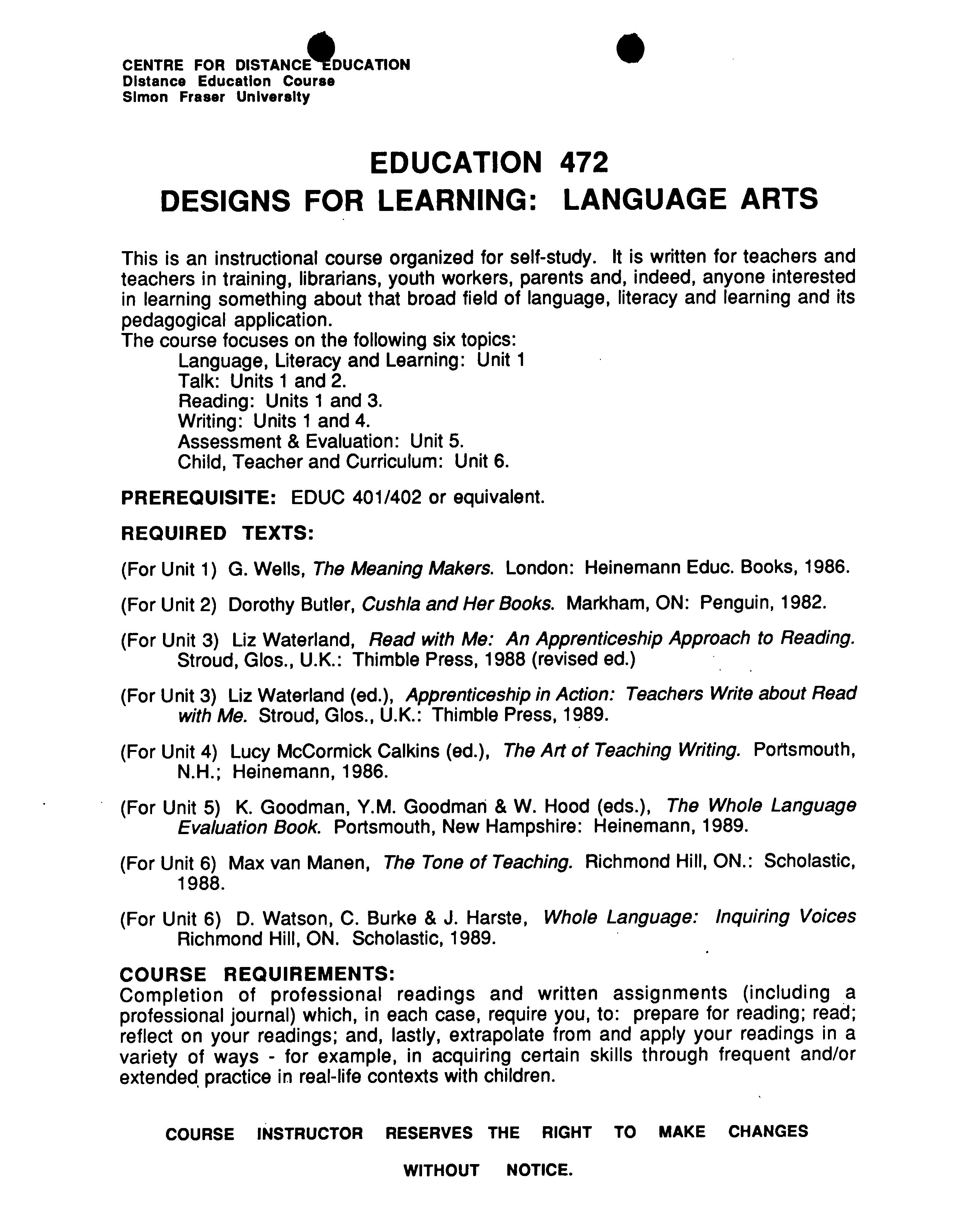. ?
.
?
C czr '
- ?
\e c)t
SIMON ERASER UNIVERSITY
EDUCATION 472-4
?
DESIGNS FOR LEARNING: ENGLISH AND LANGUAGE ARTS
Spring Semester, 1991 ?
Instructor: Mary Kooy
(January 7-April 5)
?
Phone:
?
(office) 291-
Wednesdays, 4:30-8:20 p.m. ?
(home) 574-3479
Location: MPX 7610
PREREQUISiTE:
Education 401/402 or the equivalent of a first year practicuin.
COURSE DESCRIPTION:
Education 472 will provide opportunities for teachers to examine the
theoretical foundations and the
practices arising out of current research
and theory of language learning.
Language
activity as both a means of communicating and making
meaning provides the focus for this course. Although language learning is
a complex process, children come to school language-smart. As Halliday
(1982) says, children know what language
is
because they know what
language does. Consequently, informed language instruction "enables
children to use their language resources and build on them" (Jaggar, 1985,
p.
3).
Albeit language works integratively, we will initially explore the elements
individually, always recognizing the inherent dangers in such an
enterprise. The processes of writing and reading constitutes the bulk of the
course. Languaging to make meanin
g
will inform the questions: How do
children make meaning in writing? reading? listening? speaking? What
does the current research in language acquisition imply for teaching
practices?
This course will consist of various activities: lectures; workshops and
demonstrations; seminars; individual writing tasks; collaborative learning
groups. The class structure will reflect the repertoire of strategies
applicable to actual classroom experiences.
OUTLINE OF THE TOPICS:
• Literacy: language growth and development
• Learning to Write/Writing to Learn
• The Process of Writing (from Prewriting to Publishing)
• Conventions: usage, spelling, grammar
• Learning to Read/Reading to Learn
• The Role of Literature in the Curriculum
0 ?
.
• Basal Readers
• Writing/Reading Connections
• Evaluation
• Designing 'Whole Language' Curriculum
COURSE REQUIREMENTS:
• Attendance and participation in all aspects of the course
• Completion of assigned professional readings
• Response Log: Young Adult Novel
• Additional Written/Oral Presentation
REQUIRED TEXTS:
1. Creatin g Classrooms
LlllrAuthors: The Reading-Writin Connection.
Jerome Harste, Kathy Short, Carolyn Burke, et al. Heinemann, 1988.
2.
Writing and Reading to Learn. Nea Stewart-Dore, Editor. Primary
English Teacher's Assoc., Roselle, NSW, 1987.
3. Read On e
A Conference Airoach to Readin
g
. David Hornsby, Deborah
Sukarna, Joanne Parry. Heinemann, 1986.
4.
The Read-Aloud Handbook. Jim Trelease. Penquin, 1985.
SUGGESTED READING:
• When Writers Read - Jane Hansen (Heinemann) 1987
• Understanding Writing: Ways of Observing. Learning and Teaching -
?
Thomas Newkirk, Nancie Atwell, Ed. 1988, 1986, 2nd Ed. Heinemann.
• Reading: Process and Practice - Constance Weaver 1988, Heinemann.
• How Texts Teach What Readers Learn - Margaret Meek 1988, thimble
Press.
• Whole Language: Theory in Use - Judith Newman 1987, Heinemann.
• Transitions: From Literature to Literac
y
. Regie Routman Heinemann,
1989.
• What Did I Write? Beginning Writing Behavior. Marie Clay
Heinemann, 1985.
CENTRE FOR DISTANCEDUCATION ?
is
Distance Education Course
Simon Fraser University
EDUCATION 472
DESIGNS FOR LEARNING: LANGUAGE ARTS
This is an instructional course organized for self-study. It is written for teachers and
teachers in training, librarians, youth workers, parents and, indeed, anyone interested
in learning something about that broad field of language, literacy and learning and its
pedagogical application.
The course focuses on the following six topics:
Language, Literacy and Learning: Unit 1
Talk: Units 1 and 2.
Reading: Units 1 and 3.
Writing: Units 1 and 4.
Assessment & Evaluation: Unit 5.
Child, Teacher and Curriculum: Unit 6.
PREREQUISITE:
EDUC 401/402 or equivalent.
REQUIRED TEXTS:
(For Unit 1) G. Wells,
The Meaning Makers.
London: Heinemann Educ. Books, 1986.
(For Unit 2) Dorothy Butler,
Gush/a and Her Books.
Markham, ON: Penguin, 1982.
(For Unit 3) Liz Waterland,
Read with Me: An Apprenticeship Approach to Reading.
Stroud, Glos., U.K.: Thimble Press, 1988 (revised ed.)
(For Unit 3) Liz Waterland (ed.),
Apprenticeship in Action: Teachers Write about Read
with
Me. Stroud, Glos., U.K.: Thimble Press, 1989.
(For Unit 4) Lucy McCormick Calkins (ed.),
The Art of Teaching Writing.
Portsmouth,
N.H.; Heinemann, 1986.
(For Unit 5) K. Goodman, Y.M. Goodman & W. Hood (eds.),
The Whole Language
Evaluation Book.
Portsmouth, New Hampshire: Heinemann, 1989.
(For Unit 6) Max van Manen,
The Tone of Teaching.
Richmond Hill, ON.: Scholastic,
1988.
(For Unit 6) D. Watson, C. Burke & J. Harste,
Whole Language: Inquiring Voices
Richmond Hill, ON. Scholastic, 1989.
COURSE REQUIREMENTS:
Completion of professional readings and written assignments (including a
professional journal) which, in each case, require you, to: prepare for reading; read;
reflect on your readings; and, lastly, extrapolate from and apply your readings in a
variety of ways - for example, in acquiring certain skills through frequent and/or
extended practice in real-life contexts with children.
COURSE INSTRUCTOR RESERVES THE RIGHT TO MAKE CHANGES
?
WITHOUT NOTICE.



